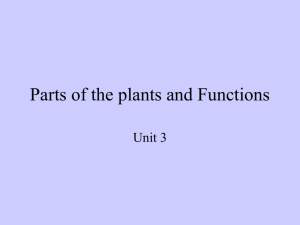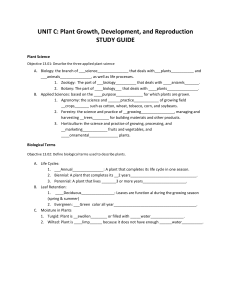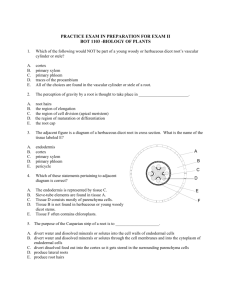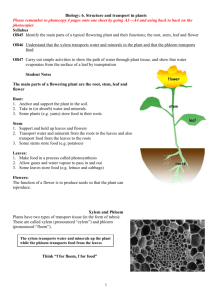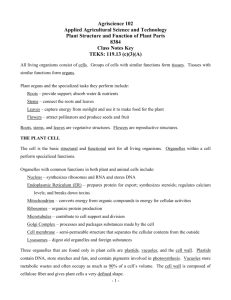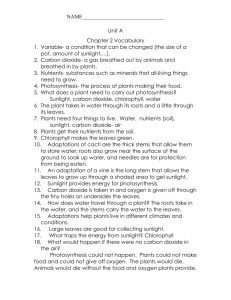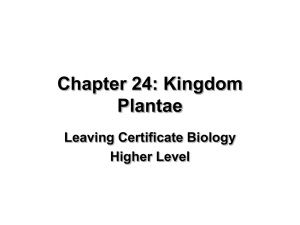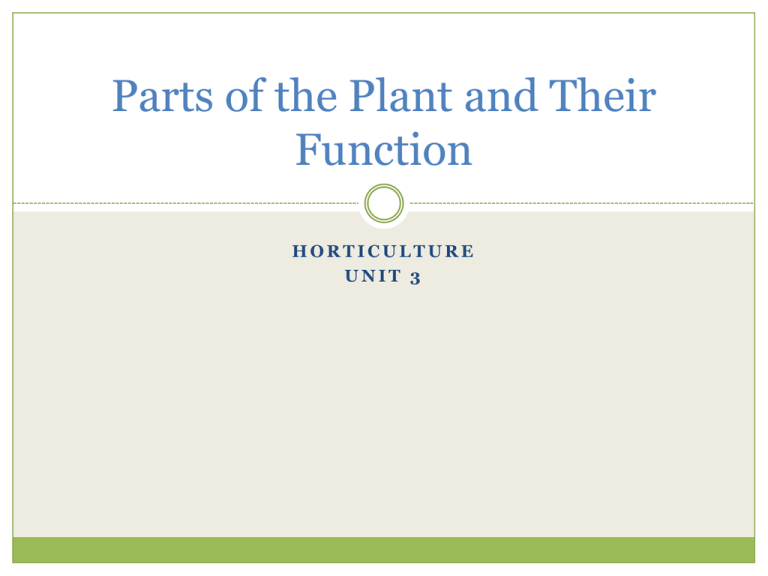
Parts of the Plant and Their
Function
HORTICULTURE
UNIT 3
Objective & Standards
To recognize the main parts of a plant and describe
the function of each.
Hort2.1 Explain the basic principles of plant
physiology and growth
Parts of a Plant
4 basic parts
Leaves
Stems
Roots
Flowers
Leaves
Produce and store all the food used by the plant
Shape and size help in plant identification
Fig 3-2 p. 27
Arrangement on the plant also differs among species
Fig 3-3 p. 28
External Leaf Structure
Internal Leaf Structure
Cuticle
Waxy outer layer of the leaf
Epidermis
the skin of the leaf
single layer of cells
Protects the leaf from losing too much moisture
Stoma
Small pore on the underside of the leaf that allow it to breathe,
exchange gases and give off moisture
Guard Cells
Open and close the stoma
Internal Leaf Structure
Transpiration
The evaporation of water through plant leaves and
stems
Necessary for plant survival
Cools and maintains the flow of nutrients and
manufactured food through the plant
Plants transpire more when it is windy, hot and
humidity is low if enough soil moisture is present
Water is pulled up from the soil by forces of cohesion
and adhesion
Transpiration When It is Dry
will slow or completely stops causing plants to wilt.
If wilting continues into evening then the plant
needs to be watered to prevent further damage to it.
During periods of drought the stomata close and
photosynthesis slows or stops because no water or
carbon dioxide moves through the leaf food factory
Transpiration When It is Wet
Plants force water from leaf vein tips to reduce water
pressure
This is why on windless humid mornings you will see
water on leaf tips and edges this is called guttation
Photosynthesis
Process by which carbon dioxide and water in the
presence of light are converted to sugar and oxygen
LIGHT ENERGY
6 CO2 + 6 H2O + 672 kcal= C6H12O6 + 6O2
Carbon dioxide + water + light energy = glucose + oxygen
CHLOROPHYLL
Photosynthesis
Food manufactured in the leaves then moves
through the stem to the roots where it is used by the
plant or stored in the stem/roots in the form of
sugar, starch or protein
Therefore a good source of light energy and carbon
dioxide, and water are important to optimum plant
production
Respiration
Occurs 24 hours a day
Plants consumes carbon dioxide and releases oxygen
Produce more oxygen than is consumed through
respiration and growth and this excess oxygen is
what is used by animals and people
Comparison of Photosynthesis and Respiration
Respiration
Photosynthesis
Food manufactured
Sun’s energy is used
Carbon dioxide used by
plant
Oxygen given off
Complex compounds form
Produces sugars and
starches
Requires light
Chlorophyll must be
present
Food consumed
Energy is released
Carbon dioxide is given
off
Oxygen used
Simple compounds form
Produces carbon dioxide
and water
Goes on day and night
Carried on in all cells
Stems
Functions
Move water and minerals from roots to leaves
Move manufactured food from leaves to roots
Support of leaves and reproductive structures of the
plant
Cohesion & Adhesion
Cohesion- magnet like force that allows water
molecules to “stick” together and be pulled up the
plant in the xylem tubes in a continuous column
Adhesion is the force that keeps the water clinging to
the walls of the xylem tube
External Stem Structure
Internal Stem Structure
Xylem
Water and minerals travel up
Phloem
Manufactured food
travels down
Dicot Stems
Xylem and phloem form two layers separated by the
cambium which produces all new cells
May continue to increase in diameter
This is due to the cambium producing new phloem cells on the
outside and new xylem cells on the inside
Monocot Stems
Only have one cotyledon
Have vascular bundles that contain both xylem and
phloem tissue
All cells are formed in the initial stages of stem
growth and there is no further enlargement of stem
size by formation of new cells
Roots
Functions of Roots
Anchor the plant
Hold the plant upright
Absorb water and minerals from the soil and conduct
them to the stem
Store large quantities of plant food
Propagate or reproduce some plants
Structure
Internal
Much like that of a stem; older roots of shrubs and trees have
phloem on the outside a cambium layer and xylem on the
inside
Both function just as they do in the stem
External
Root cap-initiates new growth and protects the root tip as it
pushed down through the soil
Root hairs- absorb moisture and minerals that are conducted
to the larger roots and to the stem of the plant
Root Structure
Types of Root Systems
Fibrous Root
Tap Root
Flowers, Fruits & Seeds
Parts of the Flower
Complete Flower
has both male and female parts
Has 4 parts
Sepals- green leaf-like parts of the flower that cover and protect the
flower bud before it opens. They form the calyx after the flower opens.
Petals-actually leaves, bright color attracts insects for pollination
Stamens-male reproductive parts of flower-consist of a filament and
anther
Pistil-located in the center of the flower, the female part of the flower
and produce the eggs. If the eggs are fertilized they become seeds. 3
parts- stigma-sticky part on top of the style that catches the pollen,
style- the tube that leads to the ovary, ovary-where the eggs develop
and grow into fruit or a seed coat
Incomplete flowers only contain male or female parts
Cells and Cell Division
Cell Structure
Mitosis
Increases the number plant cells as the plant grows
Chromosome pairs duplicate in each new cell
Each new cell is identical to the old
Meiosis
Reproductive cell division
Results in the formation of gametes or mature sex cells
Pollen is transferred from the stamen to the pistil.
Pollination occurs when the pollen adheres to the stigma
and grows through the style to the ovary
Once the pollen is in the ovary fertilization takes place
and one chromosome pair goes to one new gamete and
the second to another.
Chromosomes are composed to a protein covering
surrounding chains of DNA
Meiosis
Assignment
Complete the Unit 3 Self Evaluation-Short Answer,
Matching and Multiple Choice
DUE—Aug 26 end of period.
Activity
Flower Dissection. See worksheet for instructions


